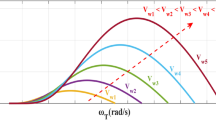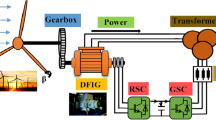Abstract
The doubly fed induction generator (DFIG) wind turbine is the most used in wind generation, and there are different control strategies for this type of machine. The correct choice of the proportional-integral (PI) controller parameters values determine the stability and performance of the DFIG when subjected to a transient disturbances. This research considers the DFIG with active power and voltage (PV) control loops, and seeks to adjust the PI controllers parameters to obtain a damped behavior and small peaks in the electrical and mechanical variables when the wind turbine is subjected to electrical faults. For the tuning, a particle swarm optimization (PSO) algorithm that minimizes an objective function (OF) is proposed, derived from the weighting of three objectives related to the dynamic performance of the wind turbine during the fault. In addition, for comparative purposes another tuning is performed via the “trial and error” method (T&E). The results of computer simulations showed that the PSO is an effective tool for this nonlinear and continuous problem, achieving an adequate tuning of the PI controller parameters, in addition to showing the difficulties of the “trial and error” method, as it is not systematic. The proposed PSO method provided a tuning improving the performance of the penalized quantities, damping the electrical and mechanical oscillations, with low peaks in the active power, terminal voltage remained within the pre-established limits, and preserving performance for different fault intensities and shaft stiffness variations.




















Similar content being viewed by others
Abbreviations
- PV:
-
Active power and voltage
- DC:
-
Direct current
- DFIG:
-
Doubly fed induction generator
- GC:
-
Grid code
- Ti:
-
Integral time (parameter)
- IAE:
-
Integral absolute error
- LVRT:
-
Low voltage ride through
- MPPT:
-
Maximum power point tracking
- OF:
-
Objective function
- PSO:
-
Particle swarm optimization
- \(C_p\) :
-
Performance coefficient
- K:
-
Proportional (parameter)
- PI:
-
Proportional-integral
- RSC:
-
Rotor side converter
- \(K_s\) :
-
Torsional stiffness coefficient
- T&E:
-
Trial and error
References
Ackermann, T. (2005). Wind power in power systems. Sweden: Stockholm.
Aguilar, M.B., Coury, D.V., Machado, F.R., & Reginatto, R. (2020). Sintonia dos controladores do aerogerador GIDA com regulação de tensão para desempenho durante falta utilizando algoritmo PSO. VIII Simpósio Brasileiro de Sistemas Elétricos - Virtual.
Aguilar, M. E. B., & Reginatto, R. (2016). Sintonia dos controladores PI de aerogeradores DFIG para desempenho durante faltas elétricas utilizando o algoritmo PSO. Congresso Brasileiro de Automática - CBA, 2016, 6.
Aguilar, M. E. B., Coury, D. V., Reginatto, R., & Monaro, R. M. (2020). Multi-objective PSO applied to PI control of DFIG wind turbine under electrical fault conditions. Electric Power Systems Research, 180, 106081. https://doi.org/10.1016/j.epsr.2019.106081.
Akhmatov, V. (2003). Analysis of dynamic behaviour of electric power systems with large amount of wind power. PhD thesis, Technical University of Denmark.
Anaya-Lara, O., Jenkins, N., Ekanayake, J., Cartwright, P., & Hughes, M. (2009). Wind energy generation: Modelling and control (Vol. 1). United Kingdom: Wiley.
Anilkumar, R., Devriese, G., & Srivastava, A. K. (2018). Voltage and ractive power control to maximize the energy savings in power distribution system with wind energy. IEEE Transactions on Industry Applications, 54(1), 656–664.
Bonyadi, M., Sc, B., & Sc, M. (2014). Particle Swarm Optimization: Theoretical analysis, modifications and applications to constrained optimization problems. PhD thesis, The University of Adelaide.
Kamel, O. M., Diab, A. A. Z., Do, T. D., & Mossa, M. A. (2020). A novel hybrid ant colony-particle swarm optimization techniques based tuning STATCOM for grid code compliance. IEEE Access, 8, 41566–41587.
Labdai, S., Hemici, B., Nezli, L., Bounar, N., Boulkroune, A., & Chrifi-Alaoui, L. (2019). Control of a DFIG Based WECS with Optimized PI controllers via a duplicate PSO algorithm. In: 2019 International Conference on Control, Automation and Diagnosis (ICCAD) pp 1–6.
Operador Nacional do Sistema Elétrico (ONS). (2017). Submódulo 3.6 - Requisitos técnicos mínimos para a conexão às instalações de transmissão. Tech. rep., ONS, Brazil.
Prajapat, G.P., Senroy, N., & Kar, I.N. (2017). Identification and tuning of dominant controller parameters of DFIG with damping control. In: 2017 IEEE Innovative Smart Grid Technologies - Asia (ISGT-Asia) pp 1–6.
Qiao, W., Venayagamoorthy, G.K., & Harley, R.G. (2006). Design of optimal PI controllers for doubly fed induction generators driven by wind turbines using particle swarm optimization. In: International Joint Conference on Neural Networks pp 1982–1987.
Reyes-Sierra, M., & Coello-Coello, C. A. (2006). Multi-objective particle swarm optimizers: A survey of the state-of-the-art. International Journal of Computational Intelligence Research, 2(3), 287–308.
Ruiz-cruz, R., Sanchez, E. N., Ornelas-tellez, F., Loukianov, A. G., & Harley, R. G. (2013). Particle swarm optimization for discrete-time inverse optimal control of a doubly fed induction generator. IEEE Transactions on Cybernetics, 43(6), 1698–1709. https://doi.org/10.1109/TSMCB.2012.2228188.
Zamzoum, O., El Mourabit, Y., Derouich, A., & El Ghzizal, A. (2016). Study and implementation of the MPPT strategy applied to a variable speed wind system based on DFIG with PWM-vector control. In: Proceedings of 2016 International Conference on Electrical Sciences and Technologies in Maghreb, CISTEM 2016.
Acknowledgements
The authors would like to thank São Carlos Engineering School, University of São Paulo (USP), as well as, Western Parana State University (UNIOESTE) for supporting this research.
Author information
Authors and Affiliations
Corresponding author
Ethics declarations
Conflict of interest
The authors declare that they have no conflict of interest.
Ethical Approval
This work is an extended version with new analyses and results of article Aguilar et al. (2020a), presented at “VIII Simpósio Brasileiro de Sistemas Elétricos” (SBSE 2020).
Additional information
Publisher's Note
Springer Nature remains neutral with regard to jurisdictional claims in published maps and institutional affiliations.
The authors would like to thank São Carlos Engineering School, University of São Paulo (USP), Western Parana State University (UNIOESTE) for the financial support.
Supplementary Information
Below is the link to the electronic supplementary material.
Rights and permissions
About this article
Cite this article
Aguilar, M.E.B., Coury, D.V., Machado, F.R. et al. Tuning of DFIG Wind Turbine Controllers with Voltage Regulation Subjected to Electrical Faults Using a PSO Algorithm. J Control Autom Electr Syst 32, 1417–1428 (2021). https://doi.org/10.1007/s40313-021-00779-w
Received:
Revised:
Accepted:
Published:
Issue Date:
DOI: https://doi.org/10.1007/s40313-021-00779-w




